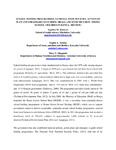| dc.description.abstract | School feeding programs have been implemented in Kenya since the 1979 with varying degrees
of success (Langinger, 2011). It began in 1979 with a government led and short lived school milk
programme (Ministry of Agriculture, -MoA, 2011). The ambitious initiative that provided free
milk to 4.3 million primary school students failed due to high costs, low accountability, and poor
road infrastructure (Langinger, 2011). This was complemented in 1989 with a World Food
Programme (WFP) lead programme, that is 71% own by WFP, 15% from local communities’
and 14 % Kenyan government (Galloway, 2009). The programme provided a daily ration of 150
grams of cereal, 40 grams of pulses, 5 grams of oil and 2 grams of salt per child per day
(Technical Development Plan, 2012). In July 2009, the Ministry of Education (MoE) in Kenya
launched the Home Grown School Meal (HGSM). It was a transition from externally-driven
school feeding programmes to Home Grown School Feeding (HGSF), which was to support
government action to deliver sustainable, nationally-owned school feeding programmes sourced
from local farmers in sub-Saharan Africa (NEPAD, 2003). In 2011,the programme had reached a
beneficiary level of 592,638 children in approximately 1,800 schools in 72 semi-arid
districts(Technical Development Plan, 2012 and Langinger, 2011).
The government has also established national policies, action plans and strategies to guide school
feeding programmes. The National Food Nutrition Security Policy (2011) with one of its objective as to increase efforts for improved nutrition and nutrition education in schools with an
emphasis on good nutrition practice and positive food habits (Republic of Kenya, 2011). The National Nutrition Action Plan (2012- 2017), it’s 6th strategic objective is to Improve nutrition in
schools ( Republic of Kenya 2012-2017). National School Health Strategy Implementation Plan
2011-2015, where nutrition in schools is one of its eight thematic areas (Republic of Kenya,
2011-2015). National school meals and nutrition strategy (2017–2022), which aims to ensure that
all children in pre-primary and primary schools receive at least one nutritious meal per school
day (Republic of Kenya, 2017-2022).
With above Government commitments to curbing food insecurity, Kenyan school going children
a yet to be food secure; a bean and maize mix that includes oil is encouraged and largely
implemented throughout schools (The Technical Development Plan, 2012). While at the same
time national food policies, strategies and action plans do not have established guidelines on the
nutritional content of school programme menus (Greenhalgh et. al, 2007and Lambers, 2009). | en_US |

